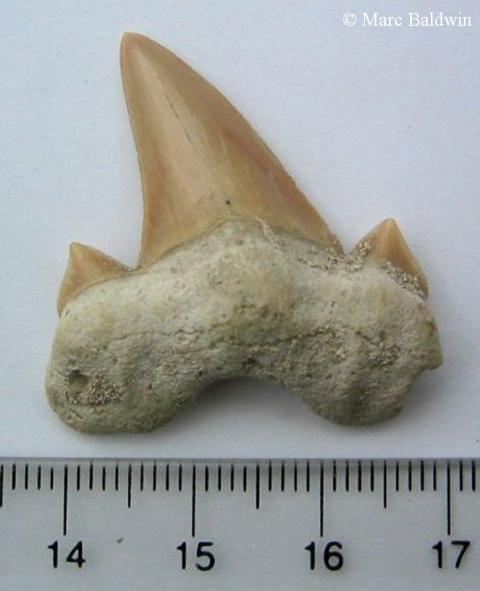Elasmobranch Evolution & Taxonomy
Evolution of a nightmare?

Cartilaginous skeletons typically don't preserve well, particularly compared with those made from bone, and this means fossil remains of sharks are very rare. Indeed, in most cases, ancient species are known only from fossilised teeth or scales. To compound a lack of fossil evidence, sharks evolve at a very slow pace, making it difficult to determine where one species "stops" and another "starts". Nonetheless, painstaking studies by palaeontologists do suggest that the earliest sharks evolved in oceans over what is now Colorado in the USA during the Ordovician Period, some 450 million years ago (mya), although scales of a genus of shark known as Elegestolepis represent the oldest undisputed shark scales and date to around 420 mya.
Since the appearance of Elegestolepis, sharks have undergone several significant radiations, the terms palaeontologists use to describe the sudden appearance of new species, the first of which happened during the Carboniferous about 300 mya and resulted in the appearance of about 45 families. Other major radiations appear to have taken place during the Jurassic (some 200 mya) and Cretaceous (~100 mya) periods and it was during the later phase that some modern sharks evolved. Indeed, some isolated fossil teeth that seem to be from a cow shark date back about 190 million years, to the early Jurassic. Today the cow and frilled sharks (Chlamydoselachus spp.) are thought to be the oldest living shark lineages. The skates, rays and guitarfishes are all descendants of a common ancestor that appeared during the late Jurassic, around 150 mya.
Aidan Martin covers the topic of shark evolution, with glorious illustrations of some of the weird and wonderful early shark body forms on his website, and the reader is directed there for a more detailed introduction.
Tangled taxonomics
Broadly speaking, sharks, rays and their kin the chimaeras are part of a group of fish called the Chondrichthyes, which translates roughly to "cartilaginous fishes". If we remove the morphologically "odd" chimaeras, we are left with the elasmobranchs (literally meaning "strap gill"); the sharks and rays. Elasmobranchs can then be divided into the selachians (sharks) and batoids (skates and rays).
Historically, recognising a shark was pretty straightforward based on its appearance and little consideration was given to whether further scrutiny of the relationships of this group was warranted. The idea that simply lumping all sharks together in a single genus (Squalus) didn't accurately reflect their diversity didn't appear until the mid-1800s and it wasn't until some of the findings made by Professor Leonard Compagno during his Ph.D. research at Stanford University, California, in the mid-1970s were published that shark researchers got their first empirical scheme for the classification of sharks.

In 1984, the Food & Agricultural Organization published the first of a two-volume set entitled Sharks of the World prepared by Prof. Compagno that, collectively, listed all 450 or so species of shark known to science and their relatedness. Compagno's taxonomic scheme, based on his meticulous study of skeletal and morphological features, rapidly became accepted as the shark classification. Compagno's scheme stood relatively unchallenged for a decade, but more recent advances in how we interpret hard and soft tissue morphology and the rise of molecular phylogenetics (i.e. using genes to assess relatedness) has since resulted in some rearrangement, although much of what he proposed four decades ago has been validated by the genetic data.
The world of elasmobranch taxonomy remains in a somewhat tumultuous state today and it's rare to come across two taxonomists that agree on the same classification scheme. Unfortunately, an attempt by Compagno to revise and update Sharks of the World in the late 1990s ended with only a single volume being published in 2001 before funds ran out. Furthermore, biologist and ReefQuest director Aidan Martin had been working on a taxonomy of sharks using a combination of hard and soft tissue morphology and genetic sequencing, but tragically passed away unexpectedly in February 2007, before he could complete his work. Personally, I choose to follow a classification part way between those proposed by Compagno and Martin, the latter of which was necessarily highly tentative. As such, in my view there are ten orders, 39 families, 104 genera and about 487 species of shark currently known to science.
In many ways, batoids are the undersold kin of sharks and have received far more scientific scrutiny; this includes their taxonomic relationships. Consequently, there are considerably fewer proposed phylogenies for the skates and rays than for sharks and, potentially therefore, greater uncertainty. Nonetheless, I again follow a hybrid scheme; in this case part way between that of Aidan Martin, that of Brian Mould, formerly, of the University of Nottingham, and that published by John McEachran and colleagues in the 1996 volume Interrelationships of Fishes. Thus, there are six orders, 22 families, 72 genera and about 560 species of skate and ray. This takes the total elasmobranch families to 61, and the species to around 1,047. While this may seem a lot of fish, it is a drop in the ocean compared to the Osteichthyes ("bony fishes") that encompass about 95% of all fish species with somewhere in the region of 435 families and more than 23,500 species.
For more information about how we classify living organisms, see my Taxonomy page.